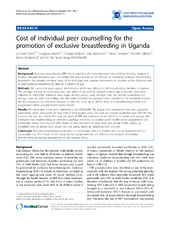| dc.contributor.author | Chola, Lumbwe | en_US |
| dc.contributor.author | Nkonki, Lungiswa Leonora | en_US |
| dc.contributor.author | Kankasa, Chipepo | en_US |
| dc.contributor.author | Nankunda, Jolly | en_US |
| dc.contributor.author | Tumwine, James K. | en_US |
| dc.contributor.author | Tylleskär, Thorkild | en_US |
| dc.contributor.author | Robberstad, Bjarne | en_US |
| dc.date.accessioned | 2012-02-06T09:53:44Z | |
| dc.date.available | 2012-02-06T09:53:44Z | |
| dc.date.issued | 2011-06-29 | eng |
| dc.Published | Cost Effectiveness and Resource Allocation 2011, 9:11 | en |
| dc.identifier.issn | 1478-7547 | |
| dc.identifier.uri | https://hdl.handle.net/1956/5546 | |
| dc.description.abstract | Background: Exclusive breastfeeding (EBF) for 6 months is the recommended form of infant feeding. Support of mothers through individual peer counselling has been proved to be effective in increasing exclusive breastfeeding prevalence. We present a costing study of an individual peer support intervention in Uganda, whose objective was to raise exclusive breastfeeding rates at 3 months of age. Methods: We costed the peer support intervention, which was offered to 406 breastfeeding mothers in Uganda. The average number of counselling visits was about 6 per woman. Annual financial and economic costs were collected in 2005-2008. Estimates were made of total project costs, average costs per mother counselled and average costs per peer counselling visit. Alternative intervention packages were explored in the sensitivity analysis. We also estimated the resources required to fund the scale up to district level, of a breastfeeding intervention programme within a public health sector model. Results: Annual project costs were estimated to be US$56,308. The largest cost component was peer supporter supervision, which accounted for over 50% of total project costs. The cost per mother counselled was US$139 and the cost per visit was US$26. The cost per week of EBF was estimated to be US$15 at 12 weeks post partum. We estimated that implementing an alternative package modelled on routine public health sector programmes can potentially reduce costs by over 60%. Based on the calculated average costs and annual births, scaling up modelled costs to district level would cost the public sector an additional US$1,813,000. Conclusion: Exclusive breastfeeding promotion in sub-Saharan Africa is feasible and can be implemented at a sustainable cost. The results of this study can be incorporated in cost effectiveness analyses of exclusive breastfeeding promotion programmes in sub-Saharan Africa. | en_US |
| dc.language.iso | eng | eng |
| dc.publisher | BioMed Central | eng |
| dc.rights | Attribution CC BY | eng |
| dc.rights.uri | http://creativecommons.org/licenses/by/2.0/ | eng |
| dc.title | Cost of individual peer counselling for the promotion of exclusive breastfeeding in Uganda | en_US |
| dc.type | Peer reviewed | |
| dc.type | Journal article | |
| dc.description.version | publishedVersion | en_US |
| dc.rights.holder | Copyright 2011 Chola et al; licensee BioMed Central Ltd. | |
| dc.identifier.doi | https://doi.org/10.1186/1478-7547-9-11 | |
| dc.identifier.cristin | 891297 | |
| dc.subject.nsi | VDP::Medical disciplines: 700::Health sciences: 800::Community medicine, Social medicine: 801 | eng |

